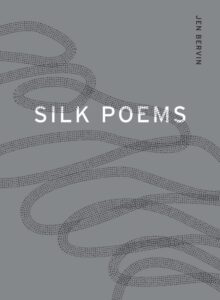Marx, Silk Poems, and the Pretext of Qualities
by Kathryn Crim
 Karl Marx’s comments on silk manufacture in “The Working Day” chapter of Capital, volume 1, demonstrate how “quality”—usually associated with “use value”—has been mobilized by capital to naturalize industrialized labor. Putting his insight into conversation with a recent multimedia poetic project, Jen Bervin’s Silk Poems (2016–17), Kathryn Crim examines the homology between, on the one hand, poetry’s avowed task of fitting form to content and, on the other, the ideology of labor that fits specific bodies to certain materials and tasks.
Karl Marx’s comments on silk manufacture in “The Working Day” chapter of Capital, volume 1, demonstrate how “quality”—usually associated with “use value”—has been mobilized by capital to naturalize industrialized labor. Putting his insight into conversation with a recent multimedia poetic project, Jen Bervin’s Silk Poems (2016–17), Kathryn Crim examines the homology between, on the one hand, poetry’s avowed task of fitting form to content and, on the other, the ideology of labor that fits specific bodies to certain materials and tasks.
The essay begins:
In “The Working Day” chapter of Capital, volume 1, where the historical detail vigorously textures Karl Marx’s argument, our attention is gradually drawn to a presumptively natural fit between workers and materials. In response to Britain’s Factory Acts, he writes, silk manufacturers complained that, if forced to reduce the working day to less than ten hours, “it would be impossible for them to buy a sufficient number of children over 13.” The exposure of this “deliberate lie,” writes Marx, quoting from the Reports of the Inspectors of Factories (1844–46), does very little to stop the manufacturers
throughout the subsequent decade, from spinning silk for 10 hours a day out of the blood of little children who had to be put on stools to perform their work. The Act of 1844 certainly “robbed” the silk manufacturers of the “liberty” of employing children under 11 for longer than 6 ½ hours each day. But as against this, it secured them the privilege of working children between 11 and 13 for 10 hours a day, and annulling in their case the education which had been made compulsory for all other factory children. This time the pretext was “the delicate texture of the fabric in which they were employed, requiring a lightness of touch, only to be acquired by their early introduction to these factories.” (406)
In his characteristic way of reading for telling turns of phrase, Marx gives us the “voice of Capital,” complaining that its rights of liberty and property have been injured by the regulations. The real physical and intellectual injury done to children, then, is not so much ignored as readily explained by the pretext offered next. A “pretext” (Marx’s German der Vorwand suggests a pretense, excuse, or smokescreen) conceals one’s real purpose; but it can be distinguished from a lie in its power to maintain a literal truth. Here, an observation about similarity slips into an argument for compatibility: the fingers and fabric are fitted together to produce a natural fact about production, that the luxury cloth “requires” a lightness of touch. As readers of Capital have often pointed out, the progressive rationalization of large-scale industry not only repressed qualitative distinctions between different kinds of labor but also eliminated qualitative variations between workers, who were progressively forced to conform their bodies to the machines. Yet Marx’s comments on silk work demonstrate one crucial way in which “quality,” fragmented and abstracted from the body, is mobilized by capital to naturalize industrialized labor.
In line with a tendency to synonymize the alienation of labor and the abstraction of exchange value from use value—in which fungible quantity is substituted for singular quality—we often assign political and aesthetic value to the concrete detail, to those marks that bring the body and the phenomenological experience of work back into view from behind the “screen” of quantitative calculation. Indeed, this revelation and re-visioning of human processes of making would seem to be one of the critical functions of art and literature. From the eighteenth-century picturesque to twenty-first century materialist poetics, an aesthetic emphasis on texture, in particular, has foregrounded the human hand in and across materials. But placing such an emphasis does not in itself constitute a critical gesture. Just as scholars of the pastoral mode have argued that representations of the laboring poor risk naturalizing structural inequality, an aesthetics of material qualities risks cultivating a palliative attitude toward the real exploitation of workers. One of my central aims in this essay is to explore how “quality” can subtend capitalist logics and to show how this history offers a lens on the critical possibilities, and limitations, of aesthetic practice. In what follows, I put Marx’s references to silk and silkworms in volume 1 of Capital in conversation with the recent poetic project Silk Poems by American artist and writer Jen Bervin. Read alongside each other, Marx and Bervin illuminate the homology between, on the one hand, the ideology of labor that naturalizes the relationship between bodies and materials and, on the other, poetry’s avowed task of fitting form to content. While Silk Poems ultimately remains entangled in the pretext of qualities that capitalist production has itself deployed, the challenge the project poses to easy forms of lyric identification, as well as to the pace and situation of literary reading, offers a critical opportunity to pursue Marx’s insight into capital’s capacity to produce and exploit sensuous knowledge.
In 2010, Bervin visited the Tufts University Biomedical Engineering Department, where she met with researchers developing a biosensor made of reverse-engineered liquified silk that, once implanted in the body, can help track “medically interesting molecules” such as hemoglobin or tumor markers. It was the potential to turn the sensor into a surface for writing that intrigued Bervin. “Due to its optical nature,” she explains, “[the silk film] can be read as a projection with fiber optic light. . . . I thought, if it is possible to write in that context—inside the body, on silk, at that scale, I wanted to think further about what else might be inscribed there.” This thinking set off a six-year long international collaborative study that took Bervin to “more than thirty international textile archives, medical libraries, nanotechnology and biomedical labs, and sericulture sites in North America, Europe, the Middle East and Asia.” Following this intercontinental journey, Bervin wrote a poem in the voice of a silkworm that draws on the worm’s five-thousand-year history of interacting with human culture, from ancient China to the Tufts Silklab. Back at Tufts, Bervin worked with David Kaplan and Fiorenzo Omenetto, along with Bradley Napier, to fabricate the poem on a silk film: The scientists “used a mask to etch the poem in gold spatter on a wafer and poured liquid silk over it. When the silk dried, the letters were suspended in the film” (173). Each line was limited to the six letters of the gene sequence, too small to be read without the help of the microscope. The pattern of the poem on the film, meanwhile, mimics the path of a silk thread made by the worm producing its cocoon. First exhibited in 2016, the Silk Poems project consists in three parts that extend poetic practice beyond the linguistic realm: the nano-imprinted poem in gold spatter on the silk film, a ten-minute video by Charlotte Lagarde documenting the research journey, and a small book, available to general audiences, published by Nightboat Books. The silk film (under a microscope) and the video were featured in Mass MoCA’s 2017 group exhibition Explode Every Day and have since been on display elsewhere in the United States and Hong Kong, along with further iterations of the project including, most recently, an artist book entitled 7S, or Seven Silks. These multiple multimedia editions testify to the open-endedness of Bervin’s initial premise: to conceive of a poem that traces and reiterates the material manifestations of silk itself. Continue reading …
 KATHRYN CRIM is a doctoral candidate in Comparative Literature at University of California, Berkeley. She is completing a dissertation entitled Fit and Counterfeit: The Emergence of a Documentary Aesthetic.
KATHRYN CRIM is a doctoral candidate in Comparative Literature at University of California, Berkeley. She is completing a dissertation entitled Fit and Counterfeit: The Emergence of a Documentary Aesthetic.
